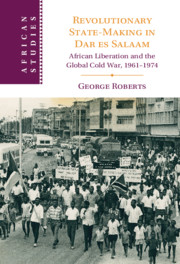Book contents
- Revolutionary State-Making in Dar es Salaam
- African Studies Series
- Revolutionary State-Making in Dar es Salaam
- Copyright page
- Contents
- Maps
- Acknowledgements
- Abbreviations
- Introduction
- 1 The Making of a Cold War City in Eastern Africa
- 2 Revisiting the Politics of the Arusha Declaration
- 3 Dilemmas of Non-Alignment: Tanzania and the German Cold War
- 4 The Assassination of Eduardo Mondlane: Mozambican Revolutionaries in Dar es Salaam
- 5 Tanzania’s ’68: Cold War Interventions, Youth Protest, and Global Anti-Imperialism
- 6 Decolonising the Media: Press and Politics in Revolutionary Dar es Salaam
- 7 Mwongozo: The African Revolution, Reloaded
- Conclusion
- Bibliography
- Index
- African Studies Series
1 - The Making of a Cold War City in Eastern Africa
- Revolutionary State-Making in Dar es Salaam
- African Studies Series
- Revolutionary State-Making in Dar es Salaam
- Copyright page
- Contents
- Maps
- Acknowledgements
- Abbreviations
- Introduction
- 1 The Making of a Cold War City in Eastern Africa
- 2 Revisiting the Politics of the Arusha Declaration
- 3 Dilemmas of Non-Alignment: Tanzania and the German Cold War
- 4 The Assassination of Eduardo Mondlane: Mozambican Revolutionaries in Dar es Salaam
- 5 Tanzania’s ’68: Cold War Interventions, Youth Protest, and Global Anti-Imperialism
- 6 Decolonising the Media: Press and Politics in Revolutionary Dar es Salaam
- 7 Mwongozo: The African Revolution, Reloaded
- Conclusion
- Bibliography
- Index
- African Studies Series
Summary
How did Dar es Salaam became a ‘Cold War city’ in Africa? This chapter sets out the principles which informed the basis of Julius Nyerere’s engagement with the outside world – a set of foreign policy coordinates which remained remarkably consistent. It then shows how a violent revolution in the Zanzibar archipelago pushed Tanganyika into a hasty union with the islands, while an army mutiny in Dar es Salaam exposed the fragility of Nyerere’s government. A series of foreign policy crises with major Western states followed. Meanwhile, Tanzania reached out to the socialist world and developed close connections with China. By the mid-1960s, Dar es Salaam had attracted the attention of the Cold War world. The remainder of the chapter then demonstrates how a ‘Cold War political culture’ became inscribed into Dar es Salaam’s public sphere and concrete spaces. Propaganda, rumour, and espionage were major preoccupations of the Tanzanian government.
Keywords
- Type
- Chapter
- Information
- Revolutionary State-Making in Dar es SalaamAfrican Liberation and the Global Cold War, 1961–1974, pp. 26 - 65Publisher: Cambridge University PressPrint publication year: 2021

